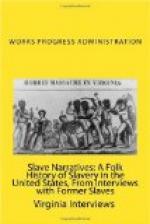“The slaves left the plantation because they were sold and their children were sold. Sometimes their masters were mean and cranky.
“The slaves used to get together in their cabins and tell one another the news in the evening. They visited, the same as anybody else. Evenings, Mamma did the washing and ironing and cooked for my father.
“When the slaves got sick, the other slaves generally looked after them. They had white doctors, who took care of the families, and they looked after the slaves, too, but the slaves looked after each other when they got sick.
“I remember in the Civil War, how the soldiers went away. I seen them all go to war. Lots of colored folks went. That was the time we were living in Detroit. The Negro people were tickled to death because it was to free the slaves.
“Mamma said the Ku Klux was against the Catholics, but not against the Negroes. The Nightriders would turn out at night. They were also called the Know-Nothings, that’s what they always said. They were the same as the Nightriders. One night, the Nightriders in Louisville surrounded a block of buildings occupied by Catholic people. They permitted the women and children to exscape, but killed all the men. When they found out the men were putting on women’s clothes, they killed everything, women and children, too. It was terrible. That must have been about eighty years ago, when I was a very little girl.
“There was no school for Negro children during slavery, but they have schools in Louisville, now, and they’re doing fine.
“I had two little girls. One died when she was three years old, the other when she was thirteen. I had two children I adopted. One died just before she was to graduate from Scott High School.
“I think Lincoln was a grand man! He was the first president I heard of. Jeff Davis, I think he was tough. He was against the colored people. He was no friend of the colored people. Abe Lincoln was a real friend.
“I knew Booker T. Washington and his wife. I belonged to a society that his wife belonged to. I think it was called the National Federation of Colored Women’s Clubs. I heard him speak here in Toledo. I think it was in the Methodist church. He wanted the colored people to educate themselves. Lots of them wanted to be teachers and doctors, but he wanted them to have farms. He wanted them to get an education and make something of themselves. All the prominent Negro women belonged to the Club. We met once a year. I went to quite a few cities where the meetings were held: Detroit, Cleveland, and Philadelphia.
“The only thing I had against Frederick Douglass was that he married a white woman. I never heard Douglass speak.
“I knew some others too. I think Paul Lawrence Dunbar was a fine young man. I heard him recite his poems. He visited with us right here several times.
“I knew Charles Cottrell, too. He was an engraver. There was a young fellow who went to Scott High. He was quite an artist; I can’t remember his name. He was the one who did the fine picture of my daughter that hangs in the parlor.




